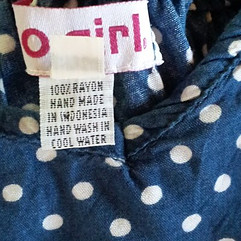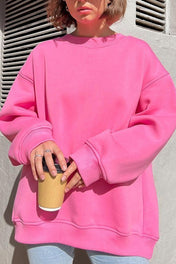Viscose fabric is made from cellulosic fibers which might make you wonder, what is a cellulose fiber?
To get a better understanding of what is a cellulose fiber, we will look at what cellulosic fibers are used for and how is viscose made. We will also explore the types of natural cellulosic fibers and man-made cellulose fibers like viscose and rayon, as well as the difference between rayon and viscose.
So what is a Cellulose Fiber?
Cellulose or cellulosic fibers are structured from a starch-like carbohydrate, called cellulose. Cellulose is a fibrous material of plant origin which can be obtained from bark, wood, the leaves of plants or other plant based materials.The main application of cellulosic fibers are in the textile industry, but they are also used as chemical filters, fiber reinforcement composites and in the medical field.
Categories of Cellulosic Fibers
There are two main categories of cellulosic fibers – those that are processed using only natural materials and those that are man-made, chemically produced.
-
Natural cellulosic fibers – include linen, cotton, hemp, sisal and ramie
 (more about them below)
(more about them below) -
Man-made cellulose fibers – viscose and rayon are the main man-made cellulose fibers (more about them below). The cellulose comes from plants that are processed into pulp. It is created by dissolving natural materials, such as wood pulp and cellulose and then regenerated by extrusion and precipitation. The fibers are extruded in the same way that synthetic fibers like nylon and polyester are made, but the cellulosic fibers are produced by regenerating dissolved forms of cellulose.
1. Classification of Natural Cellulosic Fibers
Plant or vegetable fibers are classified according to their source within plants. So natural cellulosic fibers can be divided into these three groups according to the origin in the plant.
1.Seed Fibers. Seed fibers are the most important plant fiber and is the source of cotton. There are more than 250,00 species of plants that produce seed or hair fibers, but less than one percent are used for commercial purposes and these are the main ones.
-
is the most commonly used natural cellulose fiber. The fibers grow from the seeds in the seedpod and each seedpod contains seven or eight seeds. Each seed could have up to 20,000 fibers growing from it.
-
Coir: is a stiff fiber that comes from the husks of coconuts. The fibrous mass sits between the outer shell and husk of the coconuts. It is normally used to make highly durable indoor and outdoor mats, rugs, ropes and tiles.
-
Kapok: Kapok fiber is soft, lightweight and hollow and comes from the seed of the Indian or Java kapok tree. As the fiber breaks down easily, it makes it difficult to spin into yarns. It is used as stuffing in pillows and fiberfill in other bedding products. Kapok is very buoyant and used to be used as a stuffing for life jackets and the mattresses on cruise ships.
-
Milkweed:the properties of milkweed are very similar to those of kapok.
2.Bast or Stem Fibers: Bast or stem fibers form the fibrous bundles in the inner bark or bast of the stems of the plant. These are soft fibers that are suitable for use in textiles.
-
Flax: Flax is one of the oldest textile fibers and linen fabric is made from the flax fiber.
-
Bamboo: Bamboo fibers come from the stem of the bamboo plant. Plants require very little water and no insecticides or pesticides are needed during the cultivation. This makes bamboo a sustainable and eco friendly fiber.
-
Hemp: Hemp is very similar to flax and the fibers range in length from ninety centimeters to over four meters (three to fifteen feet). The growing of hemp has a low environmental impact as it does not require pesticides. It produces 250% more fiber than cotton and 600% more fiber than flax on the same amount of land. Hemp plants can be used to extract pollutants like zinc and mercury from the soil. Hemp fibers are used to make clothing, ropes, household linens and paper, while the seeds have medicinal and culinary uses.
-
Ramie: Ramie fibers are whiter and softer than flax and are ten to fifteen centimeters (four to 6 six inches) long. Although ramie is strong for a natural fiber, it lacks elasticity, resiliency and elongation potential. It does not retain colour and dyes well, unless it is dry-cleaned. It is resistant to mildew, insects and shrinkage. Ramie is used for clothing, table and bed linens, paper, ropes and window treatments.
-
Jute: Jute is one of the cheapest textile fibers, but also one of the weakest cellulosic fibers. Jute has poor elongation and elasticity, it has low resistance to sunlight and mildew and is not colourfast. It is used to produce bags for sugar and coffee, carpet backing, wall coverings and rope. Burlap is made from jute.
Leaf Fibers: Leaf fibers run lengthwise through the leaves of monocotyledonous plants (plants that have a single or mono embryonic leaf) and are also referred to as hard fibers.
-
Pineapple (Pina): Piña fibers come from the leaves of the pineapple plant. It is used to make lightweight and sheer fabrics for clothing and table linens and it is also used to make mats.
-
Abaca: Abaca fibers come from a species of the banana tree family. The fibers are coarse and very long, up to four and a half meters (fifteen feet) long. The fibers are strong, durable and flexible and it is used to produce clothing, table linens, ropes, floor mats and wicker furniture.
2. Man-made Cellulosic Fibers
The main source of man-made cellulosic fibers is wood pulp, which usually comes from pine, spruce, or hemlock trees and also cotton linters. Cotton linters are the fine, silky, curly fibers that adhere to the cotton seeds after ginning and is used for cellulose.
Viscose fabric and rayon fabric are both manufactured from cellulose fibers that come from wood pulp. Viscose and rayon are produced in a number of ways, but regardless of the manufacturing process, the basic raw material is cellulose.
The difference between Rayon and Viscose
There is not a substantial difference between rayon and viscose and the two terms are often used interchangeably. Viscose is a type of rayon which is made from viscose, but it is also an alternative name for rayon.

It is the terminology which makes it all very confusing.
The term viscose comes from the word viscous, which is the liquid state of the spinning solution. The viscose process is the most common way in which rayon is produced these days.
Properties of Viscose Fabric
-
Viscose fabric can be produced at a relatively low cost and is commonly

-
used as a substitute for cotton because it is often cheaper to produce.
-
It is breathable and highly absorbent, making it comfortable to wear.
-
Viscose fabric drapes well because of the lightness.
-
It is easy to dye and retains colour well.
-
Viscose can be blended with other cellulosic fibers or synthetic fibers to make different textiles.
Some of the disadvantages are that viscose doesn’t age well, with yellowing of the fabric and pilling in areas of heavy wearing. Viscose is not as strong as natural cotton or flax, specially when it is wet, so gentle washing is required.
Other types of viscose fabric or rayon are modal and lyocell.
------------------------------------------------------------------------------------------------------
The article is written by Liné Cowley at ecoworldline.com





